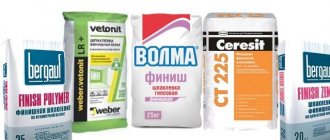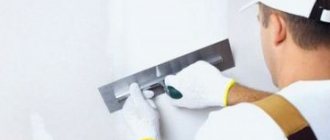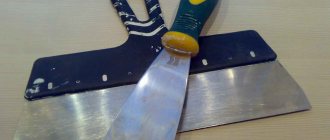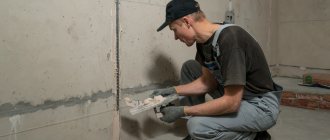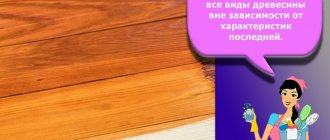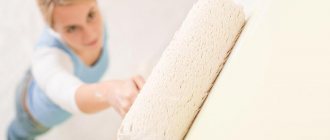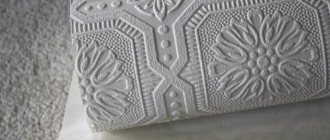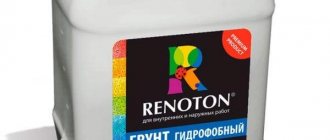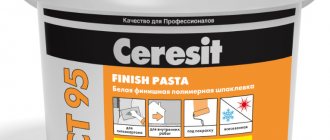Primer rating
Manufacturers of paints and varnishes produce products for interior and exterior use; they package the primer in jars from 0.5 to 20 liters. The catalogs contain products intended for specific building materials and universal compositions. When compiling the review, our experts selected products from well-known brands in all price segments for research. Performance characteristics and availability on the market were compared, and the opinions of users, professional finishers, and decorators were analyzed.
When compiling the rating, the following parameters were taken into account:
- The substrate to be treated - the materials to be painted differ in their porosity and friability. This is taken into account by manufacturers of paint and varnish products, who use additives that improve permeability and have strengthening properties;
- Adhesion – ideal adhesion should be not only to the base, but also to the finishing coating;
- Composition - to carry out repair work, you can buy acrylic, epoxy, polyurethane or alkyd primer. The drying speed, water resistance, and strength of the substrate depend on the base. The composition includes antiseptic, hydrophobic additives that change performance characteristics;
- Penetration depth varies from 1 to 40-50 mm. For porous building materials, this indicator should be at least 10-15 mm. For metal, minimum values are sufficient;
- Drying time – priming the surface is a preparatory step. The faster the primer dries, the sooner you can start painting or plastering the walls;
- Consumption - creating a substrate may require 2-3 layers - this increases costs. Single-layer application characterizes the primer on the positive side.
Not all compositions comply with SNiPs and declared characteristics. Overuse, prolonged drying, poor adhesion to the base and finishing materials - such primers were excluded from our rating.
Recommendations for choosing a primer
Purpose.
One of the starting points when purchasing soil will be the purpose of the material.
- If you need to paint concrete walls and ceilings in an apartment, you should give preference to environmentally friendly compounds with deep penetration into the base.
- To finish wooden structures, a special primer is required. It should contain antiseptic and antibacterial additives.
- When it is planned to prime the facade of a house, preference is given to materials with high resistance to weather influences. But you can ignore the smell of the product.
- Universal primers allow you to treat different surfaces. They can be located inside buildings or outdoors; substrates such as concrete, plaster, brick, wood or plastic can be processed. Paint, glue or decorative plaster is applied over the primer layer. But the performance properties of the universal composition will be worse than those of specialized products.
The basis.
Depending on the scope of application, a primer is selected on a specific basis.
- Epoxy compounds are characterized by high strength and good adhesion. But ease of use leaves much to be desired.
- Acrylic primers are environmentally friendly; water plays the role of solvent. They are widely used both in the construction industry and in everyday life.
- Polymer compositions have balanced technical characteristics. However, the cost of these modern products is quite high.
Drying speed
. During the finishing process, the drying speed of the paint and varnish material becomes an important characteristic. The faster this happens, the sooner finishing can begin. Builders consider 1-2 hours to be the optimal option, but if you plan to continue repairs every other day, you can choose primers with a drying time of 4-12 hours.
Penetration ability
. One of the basic characteristics of a primer is penetration depth. It is indicated in millimeters.
- For processing metal structures, a primer with minimal penetrating ability (up to 1 mm) is produced. This is due to the high density of the material.
- When covering concrete, wood or plaster, preference is given to a primer with a penetration depth of 10 to 15 mm. It fills the pores, allowing you to reduce the consumption of finishing material.
Consumption
. When choosing a primer, you should pay attention not only to the price, but also to the declared material consumption. Some compositions create a high-quality sublayer after the first application. When using a budget primer, you have to make a multi-layer substrate. Even if the cost of the material is low, the overall estimate can become high due to uneconomical consumption.
Our review included 22 of the best primers. These products can be purchased without problems in stores across the country. When distributing positions, the editors of simplerule magazine relied on the opinion of experts, taking into account feedback from domestic users.
Table Which is better - concrete contact or primer
| Type of material | Advantages | Flaws |
| Betokontakt | + excellent adhesion + high surface roughness + no need to remove old coating | - afraid of moisture - low penetration ability - narrow scope of application |
| Primer | + deep penetration + affordable price + ease of use + wide scope of application | - smooth surface — preparation of the base is required (removal of paint, tiles) |
The best deep penetration primers
When performing finishing work, the finishing layer is applied to concrete or plastered surface. These materials have excellent absorbency, so the primer must penetrate deeply, bind, and strengthen the surface. The prepared base will ensure adhesion to ceramic tiles and decorative plaster, and will not allow the finishing layer to collapse in the first year of operation. Our team compared the properties of 7 deep penetration primers for concrete and recommends 3 compositions with low consumption, good adhesion.
Knauf Tiefengrund
Ready-to-use composition based on polymer dispersion. Water is used as a solvent. Penetrates deeply, forming intermolecular bonds and strengthening the surface to a depth of 10-15 mm. When using Tiefengrund, water absorption is reduced and adhesion is increased.
Used on cement and gypsum based substrates. Tiefengrund is used to treat concrete walls for painting, self-leveling floors, aerated concrete and foam concrete blocks. The polymer dispersion penetrates into the structure of drywall and plaster. A primer is used for interior work and when finishing the facade, to prepare walls for gluing with heavy non-woven wallpaper or fiberglass.
Advantages:
- Used on weak grounds;
- Dries quickly;
- Does not reduce vapor permeability;
- Low consumption;
- No unpleasant odor;
- Low price.
Flaws:
- Not detected.
Good penetrating ability allows Tiefengrund to be used effectively on finely porous chalk-based substrates. Penetrating into the structure, the primer enhances strength and allows water-based paint, wallpaper or decorative plaster to be applied to the treated surface. This expands the scope of application of chalk bases.
Glims Prime Primer
The finely dispersed acrylic primer with deep penetration does not have an unpleasant odor, which makes application comfortable indoors. Antiseptic antifungal additives have been added to PrimeGrunt. The solution is ready for use, can be used for walls and horizontal surfaces. Absorbs into different grades of concrete, stone, cement plaster and brick. As a result of polymerization, it forms bonds that strengthen the surface.
It has adhesion to wallpaper paper, paint and varnish coatings, and finishing putties. Application helps reduce glue and paint consumption. When processing the screed, it does not form a film, and the surface is well removed from dust. Forms a layer that reduces water absorption of the treated building material.
Advantages:
- Provides uniform coloring;
- Low consumption;
- Abrasion resistant;
- Dries quickly;
- Suitable for outdoor use.
Flaws:
- Not detected.
Optimist G 107
The pigmented acrylic-based composition is pink, which helps control the amount of work done. A special feature is the presence of antifungal antiseptic additives. After drying, it forms a durable layer with good adhesion to finishing materials, in which fungus or mold will not settle. Environmentally friendly raw materials are used in production, and the use of water as a solvent allows the walls to “breathe.”
It is deeply absorbed into the structure of concrete, cement plaster, brick, forming strong bonds. Can be used to treat wood before painting. Used for interior work. The solution is applied not only with a brush or roller, but also with a sprayer.
Advantages:
- Low consumption;
- Drying speed – 2 hours;
- Inexpensive;
- Improves the water resistance of building materials.
Flaws:
- Unpleasant odor of antiseptic additives.
Types of primer
The primer is divided into two groups, according to the place of use: for exterior finishing and interior decoration. The first group is resistant to temperature changes, ultraviolet radiation, and precipitation. The second category is mixtures that are recommended for indoor use according to GOST.
The following groups can also be distinguished based on the surface of application:
- Wood – has high demands on building mixtures due to the rapid absorption of chemical compounds;
- Metal – requires protection from corrosion and moisture;
- Plaster – must be covered with a dense waterproof layer;
- Concrete – often used as a floor covering, so it must protect against moisture;
- Universal - suitable for any type of surface, with the exception of specific materials, as well as high levels of humidity in the room.
The composition of the primer may differ from each other.
- Acrylic;
- Alkyd;
- Minerals;
- Epoxides;
- Silicone;
- Silicate;
- Latex.
And according to the types of application, the primer is divided into three groups.
Acrylic - used more often for processing facades. It has low penetrating ability and serves to level the surface and prevent the appearance of paint stains. Acrylic primer is applied to pre-cleaned and degreased material using a brush or roller spray.
Oily – the composition includes oil resins, drying oil and solvent. It is used to coat wood or metal. The oil mixture can be tinted or diluted.
Deeply penetrating - consists of glue, bitumen and oils. It provides surface protection from mold and mildew. It also penetrates to a depth of 100 meters.
The best all-purpose primers
Universal compositions can be used for most types of finishing work. With their help, they level out the water absorption of substrates and improve adhesion before gluing all types of wallpaper, applying paint, gypsum and cement plasters. They use the best universal primers when preparing walls for facing with ceramic tiles and installing self-leveling floors. VyborExperta.ru recommends two brands that are characterized by low consumption and easy application.
Prospectors universal
The primer is intended for use indoors and outdoors, applied to walls, floors and ceilings. Has adhesion to concrete, cement plasters, gypsum. The base is a polymer dispersion to which antiseptic additives are added. After processing, uniform setting of gypsum and cement putties is ensured, and the adhesion strength of the substrate to the finishing material increases.
When processing the screed, the spreadability of self-leveling floors improves and the surface is removed from dust. The high latex content allows you to increase the strength of the base and improve its resistance to high humidity. Can be applied using a pneumatic sprayer.
Advantages:
- Regulates absorbency;
- Economical consumption;
- Drying time – 1 hour;
- Transparencies;
- Several types of packaging.
Flaws:
- Not intended for metal surfaces.
Unis universal
The products of the Russian company are supplied in cans made of durable plastic, which ensures safety during transportation. The polymer composition has good adhesion to concrete and gypsum bases and can be used to level out the water absorption of brick and natural stone before painting. It is used outside and inside buildings.
It has dust removal properties and is used to prepare the base before applying self-leveling floors. Helps reduce water absorption of the treated surface. Transportation in winter is allowed - the solution can withstand 5 freeze-thaw cycles without deteriorating performance characteristics.
Advantages:
- You can apply the second layer after 30 minutes;
- Increases the service life of finishing materials;
- Inexpensive.
Flaws:
- Only two types of packaging.
What is the best way to apply primer?
Three tools are mainly used - a roller, a brush and a sprayer.
- Application with a brush is the most popular and proven method. With its help, the user can achieve maximum penetration into all crevices. If the area is small, you should give preference to a brush.
- The paint roller also performed well. It covers a lot more area than a brush. It is used on flat surfaces, since its shape does not allow it to penetrate into small crevices.
- The sprayer is often used in professional activities to treat large areas. If you are renovating an apartment, using a sprayer is not recommended.
When applying the solution to the walls, do not forget about personal protection - wear respirators and protective gloves. Clothing should cover the body as much as possible to avoid getting the mixture on the skin.
The best primers for wallpaper
Wallpaper manufacturers offer collections on vinyl and non-woven bases, which are distinguished by their unique aesthetics. A special feature of this product is its high density. The weight of the roll is 5-6 times greater than the weight of paper wallpaper. This places increased demands on adhesive adhesion. A transparent or white primer for the wallpaper will help ensure reliable adhesion, which will not have a negative effect on the finishing coat. We offer two brands with low consumption and short drying time.
Ceresit CT 19 Betonkontakt
A German company has developed a primer for weakly absorbent concrete substrates, which improves adhesion to wallpaper and tile adhesive. Ceresit CT19 is designed for processing vertical surfaces. During production, fine-grained quartz sand is used, which makes smooth walls made of monolithic concrete rough, providing adhesion. The fraction is controlled by automated equipment.
The base is an acrylic emulsion, which is vapor permeable. This is an environmentally friendly material that can be used in bedrooms and children's rooms. Apply to walls with a roller or brush.
Advantages:
- Economical consumption;
- There is no unpleasant odor;
- Reliably fixes wallpaper on the wall;
- Variety of packaging options;
- Has antiseptic properties.
Flaws:
- Minimum drying time 3 hours.
Tex concrete-contact Universal
Made on an acrylic base with the addition of fine quartz sand. Designed for processing smooth concrete, drywall and plaster painted with alkyd paints. Provides a high level of adhesion to tile and wallpaper adhesive. The sand used in the formulation is very fine and does not provide good adhesion to a thick layer of heavy cement mortars, but the grains do not show through thin paper wallpaper.
The ready-to-use solution is applied with a roller or paint brush. Water is used as a solvent, which guarantees the vapor permeability of the formed film. A distinctive feature of the primer is a large percentage of dry residue, which reduces consumption.
Advantages:
- Minimum drying time – 1 hour;
- Can be used for facade finishing;
- Different packaging;
- No unpleasant odor.
Flaws:
- Not detected.
Specific characteristics of primers
Each mixture has its own special properties that help when processing various surfaces:
- Compositions for deep penetration - they are necessary for working on porous, loose or other surfaces that can absorb liquid like a sponge. The use of such compositions will significantly strengthen the working base and reduce the consumption of the final material, for example paintwork materials, which without a primer will be absorbed into the base in exorbitant quantities. The same compositions are perfect for surfaces intended for wallpapering.
- Antibacterial compounds are usually used in bathrooms and bathrooms, because they have water-repellent characteristics and can prevent the growth of fungus in damp areas. The adhesion in such substances is so high that the material, for example, tile adhesive, is firmly fixed to the base. From this it can be seen that the risk of crack formation is reduced significantly, which means the likelihood of the growth of harmful microorganisms will also decrease. To achieve greater effect, such compositions are recommended to be applied in several layers.
- Anti-corrosion compounds - prevent the oxidation of metals, which means successfully resisting the formation of rust.
- The compositions are non-contact (they are also adhesive) - they include the smallest grains of quartz sand, therefore, after treatment, the surface becomes rough, and it is possible to apply putty or glue wallpaper on it without effort. These compositions are used in the case when the initial surface is so smooth and incapable of absorbing liquids (i.e. does not have the required degree of porosity) that the applied material simply cannot “grasp” it.
The best primers for painting walls
Interior paints help create an atmosphere of comfort and coziness in a room; hundreds of shades allow you to choose materials for exclusive projects. A smooth surface is required for repairs. You can create the perfect base using a primer for painting walls. The composition will improve the structure, ensure uniform absorption of fine paint, and help reduce consumption.
Interior varnish with anti-mold additives
A special feature is its good penetrating ability: it strengthens loose building materials and evens out absorption. The ready-to-use solution is created on an acrylic base, the solvent is water. The formulation uses fungicidal additives that prevent the appearance of mold on slopes and in places with high humidity.
Has adhesion to cement plasters, monolithic concrete, brick. Reduces interior paint consumption by 10-15%. The composition is frost-resistant and can withstand up to 5 cycles of freezing and defrosting. Apply to vertical and horizontal surfaces.
Advantages:
- Low consumption;
- Structures the surface;
- Does not have an unpleasant odor;
- Lays flat on the base;
- Low price.
Flaws:
- Minimum drying time 3 hours.
Tikkurila Valtti Expert Base highly effective bioprotective
Finnish wood primer will help preserve the natural beauty of a façade made from natural materials. Good penetrating ability allows you to process wood with humidity up to 40%. The composition evens out absorption, façade and interior paint applies smoothly, without stains with different shade saturations.
Contains fungicidal additives that protect against mold, rot, blue stains, and fungus. This preserves the decorative qualities of the finish and extends the service life of the materials. Apply to vertical, horizontal, embossed surfaces. Prepares a substrate with good adhesion for alkyd and water-based paints.
Advantages:
- Convenient packaging;
- Drying time 1 hour;
- Water based;
- Environmental friendliness;
- Fits well.
Flaws:
- Apply with a brush only.
Pufas betokontakt BC for interior work
A universal composition with good vapor permeability, which can be used for finishing inside and outside a building. It is used in rooms with high air humidity, for priming facades and plinths of buildings. It applies not only to concrete and brick, but also to waterproof plywood and OSB boards. Apply to vertical and horizontal low-absorbent surfaces.
Contains fine quartz sand, which forms a rough substrate with good adhesion to paints and varnishes. A blue indicator helps visualize areas that have been treated. Drying time 4 hours.
Advantages:
- Does not contain organic solvents;
- Can be applied by spray;
- Good adhesion to foam;
- Convenient packaging;
- Frost resistance.
Flaws:
- It takes a long time to dry.
Briefly about the primer
Why is it necessary to prime walls?
- Strengthens the application surface;
- Provides better adhesion of subsequent material;
- Levels;
- Protects against mold and rot;
- Ensures a smooth final result;
- Absorbs the toxic smell of paint, plaster, etc.
You can prime absolutely any type of surface - floors, walls, ceilings, metal structures. The main thing is to choose the appropriate type of primer and high-quality composition. The primer fits well on brick, concrete, wood, cement, drywall
Primer is applied just like paint. Before use, it is necessary to clean the base from dirt and dust. The primer is applied using a roller, and in hard-to-reach places - with a brush. The base is always covered in two layers. The second layer is applied only after the first has completely dried. Drying depends on the composition of the solution, as well as on the temperature and seasonal conditions of the repair. The average drying time indoors is 4-6 hours, and facade drying time reaches 24-36 hours.
The best primers for exterior use
Facades and small architectural objects are subject to constant aggressive climatic influences. A primer for external use will help extend the life of paint and decorative plaster. These compositions form films that do not lose their characteristics under sudden temperature changes, frost, or exposure to solar ultraviolet radiation.
Pinotex Base
Designed for processing wooden facades, platbands, cornices, railings. It has good penetrating ability, allowing the absorption of areas with different densities to be equalized. Provides uniform coloring. Contains fugincidal additives that protect wood from rot and fungi.
It is made on the basis of white spirit solvent; when using decorative impregnations Pinotex, it guarantees double protection of wood from adverse external factors. Apply with a brush, drying time 24 hours. Forms a matte decorative film.
Advantages:
- Protects deep layers of wood from rot;
- Increases the service life of the facade;
- Saves finishing coatings;
- Increases the interval between repairs of facades;
- Low price.
Flaws:
- Strong smell.
Olsta Exterior Primer
Colorless composition with perfect adhesion to any mineral substrates. It is characterized by deep penetration into the structure, impregnates the top layer, strengthens it, forming bonds at the intermolecular level. Evens out the absorbency of concrete, brick and plaster.
The base is an acrylic dispersion that forms a film with good vapor permeability. The recipe meets the requirements of environmentalists; the company strictly controls the raw materials used and does not allow materials containing harmful substances into production. Can be used on surfaces painted with acrylic paint.
Advantages:
- Low consumption;
- Dries in 2 hours;
- Apply by brush and roller;
- High adhesion to textured decorative coatings.
Flaws:
- Overcharge.
Specifications
Any deep penetration primer includes 3 main components - water, acrylic resins and polymer components. Their proportion may be different, but the basic composition is similar, where resins are responsible for viscosity and adhesion, and polymers provide truly deep penetration.
Depending on the variety, the multicomponent composition may contain:
- antiseptics (deep-penetrating antifungal primer on concrete) – eliminate the appearance of mold and the development of fungal strains;
- silicones (water-repellent) - for outdoor use to increase resistance to precipitation;
- latex or acrylic - to increase adhesion and extend the service life of the finish coating.
Important! If the composition contains various components, the composition is called “universal” and can be used with equal success for finishing different substrates - wood, metal, concrete, brick, etc. Most often, Lakra and Volma use universal formulations.
The compositions are used on almost all surfaces, but this is especially necessary on highly absorbent, porous, crumbling and unstable substrates. Metal, for example, must be primed so that the paint applies evenly and does not roll off or crack in the future. Wood and concrete are very porous substrates, in the case of which the soil literally sticks together into a monolithic surface (film), and the paint and varnish coating lies neatly on top, without penetrating into deep capillaries.
| Characteristics | Meaning |
| Consumption, g/sq.m | 50-400 |
| Acidity | 7-8,5 |
| Penetration depth, mm | 3-15 |
| Application temperature, °C | 5-28 |
| Operating temperature, °C | -40…+60 |
Characteristics and composition requirements are regulated by GOST R 52020-2003 “Water-dispersion paint and varnish materials”, a certificate of conformity is required.
Each composition shows its own characteristics that must be taken into account when processing the base, including how long it takes for one or another option to dry. Below is a rating of the best deep penetration primers from different manufacturers. It was compiled based on customer reviews and assessments of professional builders, and also took into account the cost.
How to choose a primer
Before purchasing, you need to figure out which primer is for wallpaper and which is intended only for wood. In addition to the purpose, you need to get acquainted with the composition - this will help you choose a material that is comfortable to work with in enclosed spaces. When treating weak substrates, penetration depth becomes an important factor. You need to pay attention to additional properties and drying time. This will help you understand which primer is most suitable for the planned repair.
Purpose
The primer must be designed to be applied to the substrate to be treated. This is due to different absorbency requirements. Compositions for concrete, plaster, and wood must penetrate inside and close all pores, providing a noticeable reduction in paint consumption. The GF metal primer should remain on the surface and form a thick protective layer that prevents corrosion.
Not all compositions are universal and have the same adhesion to different mineral substrates. Smooth concrete, dense drywall, and chalk plasters are complex surfaces that require specialized components to adhere to them. The scope of application must be indicated by the manufacturer on the label.
Compound
The main component affects the main characteristics: adhesion, strength of intermolecular bonds, water resistance, resistance to solar ultraviolet radiation. According to reviews from builders, primers based on acrylic dispersion have universal properties. These solutions are low priced, environmentally friendly, and have excellent adhesion to mineral substrates. Polyurethane-based materials are distinguished by their high strength, resistance to abrasion and aggressive chemical reagents, but their price is 2-3 times higher.
The composition influences the choice of solvent. Water-soluble materials do not have a strong odor and are convenient to work with in enclosed spaces. Products based on organic solvents dry quickly, but require compliance with safety regulations: the room must be ventilated. These primers are best used outdoors.
Manufacturers add components that expand the functionality of the product. These are antiseptic, antifungal additives and components that improve the water resistance of the forming film. The information is relevant when choosing a primer for rooms with high humidity.
Penetration depth
The characteristic is relevant for porous substrates. The deeper the solution penetrates, the more pores are filled. This provides increased strength, minimizes paint or glue consumption, and makes adhesion to decorative plaster better and more durable. Deep penetration compositions fill pores to a depth of 10-15 mm, for weak bases this value reaches 20-25 mm, for dense bases - 5-10 mm. This parameter is taken into account when choosing a primer material for plaster, screed, concrete and wood. The penetration depth for metal primers does not matter.
Drying time
Surface priming is an intermediate operation on which finishers do not plan to spend much time. It is recommended to give preference to solutions that dry within 1-2 hours. The crew can spend this time eating lunch and continue painting, tiling, or wallpapering when it’s finished. If the primer dries within 3-4 hours, then it is better to use it on large areas or when there are parallel tasks in other areas of the construction site.
Properties
Primers are produced with different properties - strengthening, universal, concrete contact, antiseptic. The functionality is expanded due to polymer modifying additives. When choosing, you need to take into account the tasks being solved. Strengthening agents are intended for weak porous building materials. Penetrating into the structure, they form bonds that increase the strength of the surface layer. This makes the clutch stronger and increases the interval between scheduled repairs.
Universal primers are relevant when processing various building materials indoors and outdoors. Concrete contact is designed to improve the roughness of surfaces made of monolithic concrete and arched structures. Its recipe uses quartz sand. When choosing, the composition of the fraction is important, which depends on the purpose. Small grains are used for primers for wallpaper or painting. Larger fractions are relevant when plastering walls.
How to choose a primer
The first thing to consider when purchasing a primer is the distinctive characteristics of the material on which it will be applied.
Secondly, the color of the primer is important. The brighter and more noticeable it is, the more visible defects or irregularities will be. And at the very beginning there is a chance to eliminate defects.
Thirdly, you should consider where the base is located - outside or inside the building. Here you will need to select a mixture with special properties.
And it is important to consider what mixture will be applied on top - varnish or paint. Since varnish requires a high degree of smoothness.
There are several unspoken rules when selecting primer material. For unstable and loose surfaces, universal mixtures with deep penetration are purchased. In this case, the composition will completely process the material and create a water-repellent film.
In rooms with high humidity, it is recommended to use products with antifungal agents and additives.
Particular attention should be paid to priming walls for painting. The composition of the mixture must match the composition of the paint so that the coating is sufficiently fixed. There will also be no stains or streaks.
The primer for plaster also has distinctive features. It must have antiseptic properties and treat the base from dust.
Which primer is better
Surface priming is used at different stages of finishing and facade work. Wood, metal, concrete, plasters and gypsum blocks are processed. Which primer should I choose for walls, and which one is better for installing a self-leveling floor? To solve these problems, it is better to use different brands of primers. All products from our rating are available in Russia. The VyborExperta.ru team recommends using the following compositions from our review:
- Knauf Tiefengrund - for working with gypsum and chalk;
- Glims Prime Primer – for plastering on porous surfaces;
- Unis universal – for multifaceted work outside and inside the building;
- Ceresit CT 19 Betonkontakt - choice for gluing heavy wallpaper;
- Pufas betokontakt BK – for painting walls;
- Tikkurila Valtti Expert Base – for facade woodwork;
- Olsta Exterior Primer – primer for exterior finishing of buildings.
Surface priming is a mandatory technological stage when performing finishing work. The best compositions will help reduce the consumption of expensive finishing coatings and increase the strength of the decorative layer.
Purpose and properties of the deep penetration composition
Deep penetration primer is a special multi-component composition, used on loose and porous surfaces. Primers are designed for use on concrete, wood, and metal and are divided into types that have the desired properties.
Deep penetration primer is used to prepare various surfaces and strengthen them, which improves the quality of the finish. At the same time, improve the performance characteristics and service life of the coating.
A special deep penetration primer reduces the ability of the working surface to absorb water, firmly holds together the smallest particles of material, thereby strengthening the base.
Compound
Regardless of the manufacturer and purpose of the primer, it will always contain the following components:
- acrylic resins that provide excellent protection against moisture and bond with finishing materials;
- polymers that provide rapid penetration deep into the surface;
- water is necessary for better penetration of substances, as well as to regulate the amount of active components per unit volume.
Depending on the type of primer, antifungal substances may also be added to it, which protect the walls from the formation of mold. When treating rooms with high humidity, silicone is also added to the mixture. When working with heavy or very hard finishing materials, a latex-based primer is used, which enhances the adhesive (binding) properties several times.
Features of primers with non-contact mixtures
In practice, non-contact primer has proven itself to be far from being the optimal option for preparing surfaces before laying ceramic tiles, much less porcelain stoneware. This is due to the fact that tile adhesive has a higher adhesive ability than the soil itself. The adhesion strength of tile adhesive starts from 0.5 MegaPascals, while for a non-contact composition it is only 0.4 MegaPascals (with crumbling, weakly absorbent materials). All this leads to a decrease in the direct adhesion of the glue to the surface. Due to the large mass of porcelain stoneware or ceramic tiles, increased pressure will be created on the primed base. As a result, the non-contact may “peel off” from the surface along with the tiles or begin to peel off.
In order to avoid a negative result, in the process of preparing the base it is necessary to use high-quality primers from well-known brands. It is also not recommended to use non-contact solutions on various types of loose surfaces. On such substrates, the primer will not be able to provide the adhesion declared by the manufacturer. The adhesion force of the mineral base to the applied layer will be significantly reduced. Taking into account the fact that the adhesion of plaster solutions starts from 0.3 MegaPascals, one cannot expect a positive effect from such treatment.
In addition, you should not apply non-contact solutions to non-absorbent substrates, which include plastic, metal or wooden surfaces (some types of wood). With such bases, the layer will not be able to adhere normally, and even if this happens, we must not forget about the main property of non-contact - its vapor permeability. The accumulation of condensation between the primer and the surface will very quickly lead to the appearance of defects.
Rating of leading primer manufacturers
- Knauf (Germany). Produces a variety of dry mixes and mortars. The line includes primers for different types of surfaces, the most popular being Haft-emulsion, Betokontakt, Tiefengrund and others.
- Ceresit (Germany). High-quality products that have been in demand on the market for many years. The mixtures can be made in Russia and Germany, but using the same technologies. The most popular primers: ST 15 (silicone), ST 16 (acrylic), ST-17 (universal).
- Vetonit (Germany). It is found less often in stores, but is of high quality. The most popular mixtures are MD16 (for floors) and Vetonit Dispersio (universal, also suitable for materials with rapid absorption).
- Birss (Russia). A group of companies whose production is located in the Russian Federation. The most popular primers are Betonkontakt (water-dispersion) and universal (for interior and exterior work).
You can also opt for the following brands: North, Osnovit, Unis, Bona, Berger, Belinka and others.
Choose carefully, because the surface properties will depend on the quality of the composition.
Types
When working with various objects, it is advisable to use a suitable material that meets all the technical features of a particular surface.
Universal
Suitable for interior and exterior decoration of buildings. Typically used in cases where increased protection from mold, mildew or sunlight is not required. Sold as a ready-made solution in canisters. Quickly penetrates the surface, making it smooth and clean. Does not require long waiting times to dry. Can be applied horizontally and vertically. Such a primer only conditionally refers to deep penetration mixtures, since it can penetrate a maximum of 3-4 mm into the wall.
Latex
Works great on old and untreated wood, plaster and concrete. The treated material does not crumble, since a breathable film is formed on its surface. Typically, such mixtures contain antiseptic and antifungal additives. Often, pigment is added to a latex-type primer for ease of surface treatment, since it is clearly visible how densely and evenly the substance is applied. They are distinguished by a high price.
With the addition of acrylic
It dries quickly regardless of the walls being treated. Used when working with wood, concrete, brickwork or plaster. You can also apply it in any way. Dilute with water to the desired consistency.
When purchasing an acrylic primer, do not confuse it with the same primer, but of a strengthening type. The second type does not have the same good penetrating properties.
Antifungal
The mixtures are based on fungicides or substances with a similar mode of action. They do not allow harmful fungi to multiply, protecting the walls from mold. This type of deep penetration primer is used in damp areas. Apply strictly to a dry surface.
Antiseptic
Manufactured on the basis of alkyd resin. After application to the surface, it forms a thin film that does not allow water to penetrate the material. Antiseptic mixtures are used on wooden surfaces.
Polymer mixture
Considered one of the best on the market. Not afraid of mechanical impact, protects from burning. It also dries in just a few hours. Due to the large number of binding elements, it has increased adhesion. Can be applied to almost any surface.
Expert opinion
Mezentsev Sergey Petrovich
Residential renovation and finishing specialist
Despite such a large number of positive aspects in the use of polymer mixtures, they still have a weak point. They do not contain antiseptics or fungicides, so they do not protect against fungi and mold at all.
Facade
Used only for external finishing work. Additionally, the composition of the mixture is enriched with additives taking into account the climate in which the object is located. These can be antifreeze substances that are not afraid of the sun or moisture. The composition also includes antiseptics and antifungal additives. Deep penetration façade primer should be used only of the silicone type. They are able to protect the building from water penetration and subsequent fungal growth.
Special mixture for concrete
Used when processing thick walls. The substance penetrates to a depth of almost 1 cm. The composition of such mixtures includes a large amount of latex. It forms a thick film on the surface, which makes it impossible for water to penetrate and form fungal colonies. The material perfectly protects against dust and makes the walls stronger. It has increased adhesive properties due to excellent sealing of pores.
